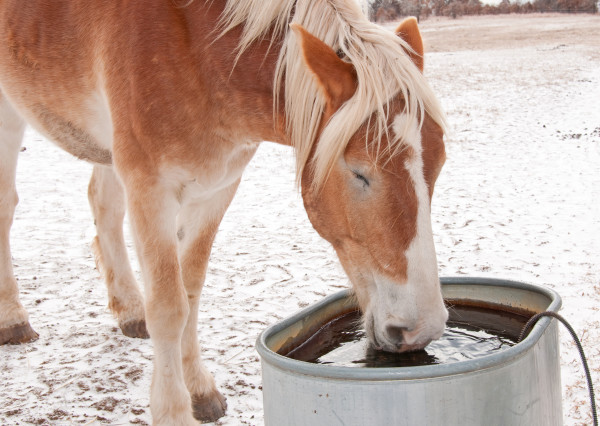Home > Horse Care > Are you increasing your horse’s colic risk?
Are you increasing your horse’s colic risk?
- February 20, 2025
- ⎯ Equus
Winter colic in horses isn’t an unfounded fear. When asked to describe the most common cold weather equine health problem in their areas, veterinarians around the country respond with near unanimity: Colic. Even in the Southwest, where frigid temperatures are rare, cases of impaction and sand colic spike during the winter months.
Three common practices
Three cold-weather practices converge to increase the likelihood of intestinal blockages (impactions) this time of year:
- Failing to ensure that your horse drinks enough water. Horses tend to consume less water in colder weather. Why? Because they don’t get as thirsty as in the summer or because their water sources freeze over. In addition, the roughages common in winter rations contain less than water. Winter hay contains about 20 percent moisture while spring and summer grass contains 75 percent or more water content. With insufficient liquid in the digestive tract, the food being digested becomes too dry to be moved along by peristaltic action and blocks a portion of an intestine. The stemminess of poor-quality hay contributes further to blockage formation.
- Boosting grain to provide more energy. When the temperature drops, many caretakers try to meet the increased energy demands if keeping warm by boosting their horses’ grain rations. This disproportion of carbohydrates to fiber can upset digestion.
- Keeping your horse in a stall. The digestive system depends on body movement to help push food along. At pasture, a horse spends the bulk of his time wandering from one grazing spot to the next. The inactivity enforced by confinement in stalls or small paddocks may slow the movement of ingesta along the digestive tract.

What to do instead
Cold weather may conspire against your efforts to keep water flowing to your horses, but they are crucial to preventing colic. “We have gotten many of our clients to give their horses warm water and electrolytes [in their feed] during cold spells,” says Jeffrey Witwer, VMD, of Camden, South Carolina. “Anything that can be done to keep the horses drinking reduces the incidence of colic.” Your particular “anything” may be purchasing water-trough or -bucket heaters, carrying hot water to thaw frozen buckets and pipes or trekking twice daily to the stream to break a hole in the ice and check on the footing.
Leave your horses turned out as much as possible to ensure sufficient digestive stimulation. You won’t be endangering their health in other ways, as horses in good condition with heavy winter coats or adequate blankets and access to windbreaks can withstand temperatures as low as 40 degrees below zero. They are better off outdoors except in drenching rain or stinging ice.
Finally, reach for an extra flake, not scoop, when temperatures start to drop: It’s hay, rather than grain, that provides the most efficient heating fuel. And roughages don’t produce the carbohydrate overload that can trigger endotoxemia, a potentially deadly system-wide toxicity that can lead to laminitis.





